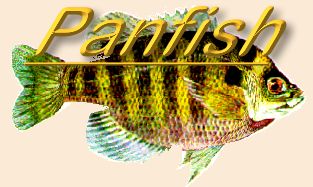By mid to late summer and into the early fall
a lot of crappies have moved into the deeper,
cooler waters of natural lakes and reservoirs.
Finding them and fishing for them with a fly
rod is usually a combination of pure luck and
a lot of time. However, there is an alternative
to solving this problem but from a "purists"
point of view, it's cheating.
During the spring and late fall a lot of
crappies can be had in shallower waters
which can easily be fished from either the
shore line, by wading, or tubing. But, usually,
by mid-July they've moved into the deeper,
cooler waters, usually near the channels or
other drop off points. The other problem is
that they are usually suspended between 10
and 15 feet down in 20 to 25 feet of water.
An exception to this is when the water is very
stained or turbid. Sure you can still use a
float tube (and take your chances with the
boats out cruising the water) but unless you
have a good, detailed, map of the lake or water
way you'll wear your legs out trying to find
those areas and can only hope to find the fish.
My solution is using a boat equipped with a
sonar device or "fish locator," fast to medium
sinking lines, sinking flies, and marker buoys.
Using the electronics helps tremendously in
cutting down on the time it takes to find
channels, deep holes, bottom structure and the
fish. If the fish are suspended midway between
the top and the bottom the fish locator also
shows you their depth. You'll need that
information to determine your "count down" when
you start casting, waiting for the fly to reach
the correct depth, and start stripping the fly
back towards you.
Here's the system I use: First, I already know
the sink rate of the line I'm using, that way
I know how many feet per second the line and
fly will sink. Most sinking fly lines come with
that information now days. If you're not sure
you'll have to experiment a little to figure
the sink rate. Next, using my boat and electronics
I cruise around the lake area to find the channel
(yes, I also use a GPS system) and mark the way
points on the GPS or watch the depth and fish
locator screen. When I find a group of fish I
note their depth but I don't stop the boat. I
drop in a fish marker buoy and continue on. A
marker buoy is basically a dog-bone shaped wooden
dowel or plastic device with string wrapped around
it and a heavy sinker attached to the string. To
use it, wrap a string (longer than the lake is
deep) around the center of the spool and attach
the weight to the end. When you pass over a group
of fish drop it over the side of the boat. The
weight will unwind the string from around the
float. Once the weight hits the bottom the string
stops unwinding and the float stays pretty well
where you dropped it. Now proceed about 20 to
30 feet farther beyond the buoy before you stop
and anchor the boat. Any closer and you'll
probably scare the fish off.
Now, with the buoy marking where the fish are
and the fish locator telling you how deep they
are, you're ready to fish. Use the buoy for a
target but try to over cast it by 10 to 15 feet
because as the line sinks it will naturally arc
back towards the boat. If you only cast as far
as the buoy and the fish are 15 feet down by
the time the fly gets to the depth it'll be at
least that far away from the fish and they
probably will never even notice it.
Make your over cast and count down the line
sink time leaving the line slack. Then, slowly
and erratically, start stripping the line back
towards the boat. When you feel a hit, don't
try to set the hook immediately or you'll either
rip the fish's lips or pull the fly out of its
mouth. Make sure the fish has the fly, then,
slowly lift your rod tip to set the hook. You
know what to do after that. Just try to keep
the fish from getting tangled in the buoy line.
I don't limit my flies to just streamers either.
I also use nymphs, wet flies, small crawdad
patterns, and even terrestrials. Believe it or
not, I've even caught crappies that were 12 feet
deep on a bumble bee pattern!
The one thing I always try to point out: there
are "fly-fishing purists" and fly anglers. Some
of us like to fish, other like to catch (and even
eat the fish we catch). You can be both in different
situations, or any combination in between. I always
think that catching is better than just fishing.
Regardless of your point of view, get out and go fish!
Randy Fratzke, Iowa
|



